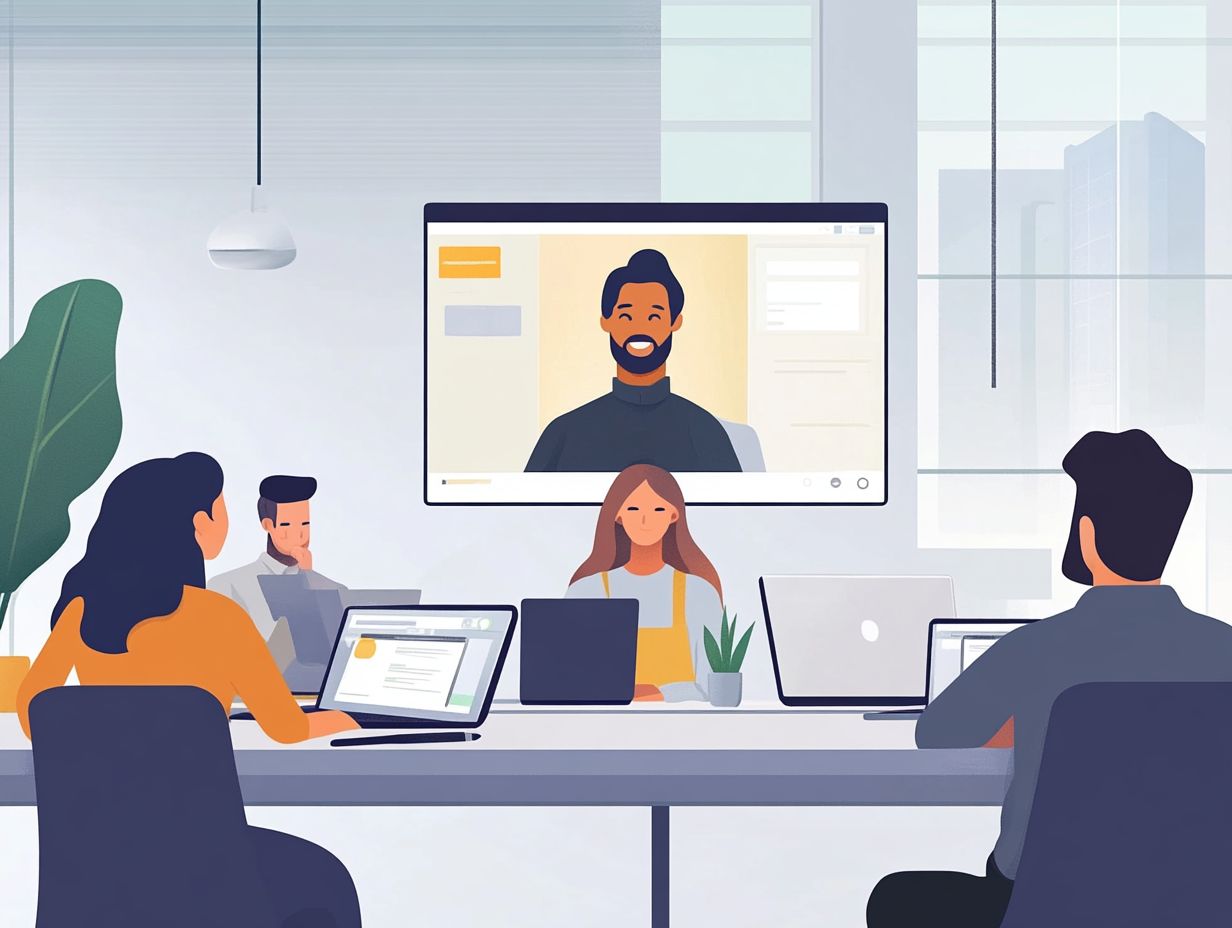E-Learning Best Practices for Corporate Training
In today s fast-paced business landscape, effective corporate training is not just a nice-to-have; it s essential for your employees’ development and the overall success of your organization.
With the emergence of e-learning, you have a unique opportunity to implement innovative training solutions that cater to various learning styles.
This article delves into the myriad benefits of corporate training for both employers and employees. It outlines best practices for designing and delivering engaging e-learning experiences while guiding you in selecting the right platforms for your needs.
Additionally, it discusses key metrics for measuring success and addresses common challenges you might face along the way. Whether you re an HR professional or a team leader, this guide will empower you with the knowledge to elevate your corporate training initiatives.
Contents
- Key Takeaways:
- The Importance of Effective Corporate Training
- Best Practices for E-Learning in Corporate Training
- Choosing the Right E-Learning Platform
- Measuring the Success of E-Learning in Corporate Training
- Common Challenges and Solutions
- Frequently Asked Questions
- What are the benefits of using e-learning for corporate training?
- How can I ensure successful implementation of e-learning in my corporate training program?
- What are some best practices for designing e-learning modules for corporate training?
- How can I encourage employee participation in e-learning for corporate training?
- What are some common mistakes to avoid when implementing e-learning for corporate training?
- How can I measure the success of my e-learning program for corporate training?
Key Takeaways:

- Corporate training boosts employee skills and productivity.
- Engaging delivery is key for successful e-learning.
- Choose e-learning platforms that are easy to use and offer good support.
The Importance of Effective Corporate Training
Effective corporate training is crucial in today’s business landscape, especially for organizations focused on boosting workforce engagement and employee retention. Learning how to use technology in corporate training effectively can enhance these efforts significantly.
By adopting a tailored approach to corporate learning, you can provide Millennials who represent a significant segment of the workforce with the tools and resources they need to thrive.
This strategy encourages continuous improvement and builds a culture rich in coaching opportunities and personalized learning experiences. In doing so, you ll develop a more skilled and confident team, ready to tackle the challenges ahead.
Benefits for Companies and Employees
The advantages of corporate training are clear and impactful for both organizations and employees. It cultivates a mutually beneficial environment that helps employees remember what they learn and boosts workforce engagement.
When you invest in tailored training programs, you can significantly elevate productivity. This ensures that your employees possess the latest skills and knowledge essential to their roles.
This personalized approach is especially appealing to Millennials, who prioritize growth opportunities and crave engaging learning experiences that align with their interests and career ambitions.
Adopting effective training strategies not only boosts overall performance but also uplifts employee morale. This builds a vibrant culture of learning that energizes your team.
Your organization is likely to experience improved retention rates and a more motivated workforce. This positions you for success in a competitive market.
Best Practices for E-Learning in Corporate Training
To truly maximize the impact of e-learning in your corporate training initiatives, it’s essential to adopt best practices for corporate training that cater to a variety of learning styles.
By ensuring that the content remains both engaging and effective, you elevate the overall experience for your team, fostering a culture of continuous learning and growth.
Design and Delivery Strategies

Implementing effective design and delivery strategies is essential for crafting impactful e-learning courses, as showcased in e-learning success stories from top corporations, that significantly enhance knowledge retention and workforce engagement.
By utilizing adaptive learning paths, which are personalized learning experiences that adjust to each person s pace, you can tailor the learning experience to fit individual needs. This allows participants to progress at their own pace while addressing their unique strengths and weaknesses.
Incorporating interactive content, or fun and engaging activities that keep learners involved, fosters greater participation, keeping learners engaged an absolute necessity for long-term retention.
When your training materials align with real-world applications, they become far more relatable and meaningful. This relevance deepens understanding of the subject matter and gives the power to your workforce to apply their knowledge directly to practical scenarios, ultimately enhancing overall performance and job satisfaction.
Engagement Techniques
Engagement techniques such as gamification (adding game-like elements to learning to make it more fun) and social learning are essential for keeping you actively involved and motivated during e-learning sessions.
By weaving in elements like collaborative projects and peer-to-peer interaction, your organization can cultivate a sense of community and shared purpose. Consider creating team challenges where you and your colleagues work together; this can greatly enhance communication and collective problem-solving skills.
Gamification transforms what could be mundane content into interactive experiences. You can earn rewards, unlock new levels, and compete for top scores. This playful approach not only makes learning enjoyable but also significantly improves retention rates, as you re more likely to remember information when it s presented in an engaging and fun way.
Choosing the Right E-Learning Platform
Choosing the right e-learning platform can make or break your training success! It should seamlessly align with your organization’s training objectives while ensuring a user-friendly experience for all participants. Consider exploring e-learning solutions that effectively bridge knowledge gaps in corporations.
Factors to Consider
When selecting an e-learning platform, you must consider several crucial factors to ensure it aligns with your specific corporate training needs, such as those outlined in the top 10 e-learning platforms for corporate training.
As you explore effective training solutions, the overall cost is paramount. Your budget will significantly influence the quality and reach of the program.
Ease of use is another vital consideration. Intuitive platforms reduce the learning curve for employees, enabling them to engage swiftly and effectively.
Customization options allow you to tailor the learning experience to fit your unique objectives, making the training more pertinent and impactful.
Robust analytics features provide valuable insights into learner progress and engagement, giving you the power to measure effectiveness and refine your strategies. Strong reporting tools are essential for tracking these metrics.
Reliable support services can enhance the training experience by addressing any technical issues promptly. This ensures a seamless learning environment for all participants.
Measuring the Success of E-Learning in Corporate Training

Measuring the success of e-learning initiatives in corporate training is essential for grasping their impact on employee performance and knowledge retention. To enhance these efforts, consider exploring how to start a corporate e-learning program. Unlock the full potential of your e-learning initiatives by evaluating these programs for valuable insights into how effectively they enhance skills and foster a culture of continuous learning within your organization.
Key Metrics to Track
Key metrics to track in e-learning include assessment results, engagement levels, and overall improvements in employee performance.
By leveraging pre- and post-training assessments, you can gain invaluable insights into how effectively knowledge has been absorbed. This helps pinpoint any gaps that may require further attention.
Measuring the time spent on training modules reveals whether the content is engaging and relevant. This helps to ensure that learners remain motivated throughout the process.
Observing how well individuals apply their newfound skills on the job is crucial; this can be assessed through performance reviews or feedback mechanisms that highlight the real-world application of knowledge.
Together, these metrics provide a comprehensive view of the effectiveness of your e-learning program. Act now to track these metrics and transform your training programs!
Common Challenges and Solutions
While e-learning presents numerous advantages, it also brings forth common challenges that you must navigate to ensure effective corporate training and maintain workforce engagement, as highlighted in the evolution of e-learning in corporate training.
Addressing Technical and Engagement Issues
Addressing technical and engagement issues is crucial. This maximizes the effectiveness of e-learning in corporate settings for your training programs.
You should definitely adopt a variety of strategies. These not only troubleshoot technical difficulties but also improve your platform’s functionality.
Regular updates are a must! Assess the ease of use of your interface and provide comprehensive support resources.
You can boost user engagement by adding fun activities like quizzes and discussion forums. Involving participants in their learning journey creates a dynamic atmosphere.
Frequently Asked Questions

What are the benefits of using e-learning for corporate training?
E-learning offers flexibility, saves money, and scales easily. It allows personalized learning experiences and tracks progress effortlessly.
How can I ensure successful implementation of e-learning in my corporate training program?
Have clear goals in place. Involve key stakeholders and provide proper training and support.
What are some best practices for designing e-learning modules for corporate training?
Use engaging content and multimedia elements. Break down complex information into smaller modules.
How can I encourage employee participation in e-learning for corporate training?
Offer incentives and create a positive environment. Align training with employees’ career development.
What are some common mistakes to avoid when implementing e-learning for corporate training?
Avoid poor communication and overlook technical issues. Regularly update content and address individual learning needs.
How can I measure the success of my e-learning program for corporate training?
Track completion rates, learner satisfaction, knowledge retention, and job performance impact.






